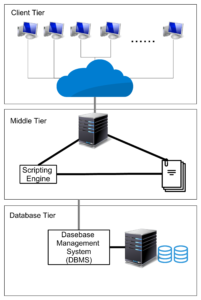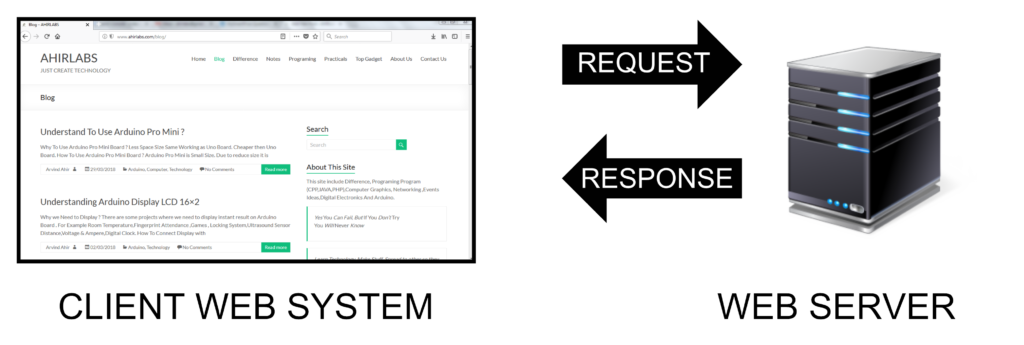Web Database
A web database is a wide term for managing data online. A web database gives you the ability to build your own databases/data storage without you being a database guru or even a technical person.
Examples: banks, airline and rental car reservations, university course registration and so on
- The Web is a distributed information system base on hypertext.
- Most Web documents are hypertext documents formatted via HTML
- HTML Documents contain
- Text along with font specifications, and other formatting instructions
- Hypertext links to other documents , which can be associated with region of the text.
Data Organization
Web databases enable collected data to be organized and cataloged thoroughly within hundreds of parameters. The Web database does not require advanced computer skills, and many database software programs provide an easy “click-and-create” style with no complicated coding. Fill in the fields and save each record. Organize the data however you choose, such as chronologically, alphabetically or by a specific set of parameters.
Web Database Software
Web database software programs are found within desktop publishing programs, such as Microsoft Office Access and OpenOffice Base. Other programs include the Webex WebOffice database and FormLogix Web database. The most advanced software applications can set up data collection forms, polls, feedback forms and present data analysis in real time.
Applicable Uses
Businesses both large and small can use Web databases to create website polls, feedback forms, client or customer and inventory lists. Personal Web database use can range from storing personal email accounts to a home inventory to personal website analytics. The Web database is entirely customizable to an individual’s or business’s needs.
MySQL
Often in the world of Web databases, MySQL (structured query language) will be mentioned. This is a relational database management system that manages different Web databases. It operates as a server, and is an open source project. MySQL is often included with Web hosting for managing either personal or business website databases. It is a programming language, so is a more difficult to work with than a straight Web database software program.
Database Applications and the Web :
Most of the services we enjoy on the Web are provided by web database applications. Web-based email, online shopping, forums and bulletin boards, corporate web sites, and sports and news portals are all database-driven. To build a modern web site, you need to develop a database application.
This book presents a highly popular, easy, low-cost way to bring together the Web and databases to build applications. The most popular database management system used in these solutions is MySQL, a very fast and easy-to-use system distributed under an Open Source license by its manufacturer, MySQL AB. We discuss MySQL in detail in this book.
With a web server such as Apache (we assume Apache in this book, although the software discussed here works with other web servers as well) and MySQL, you have most of what you need to develop a web database application. The key glue you need is a way for the web server to talk to the database; in other words, a way to incorporate database operations into web pages. The most popular glue that accomplishes this task is PHP.
PHP is an open source project of the Apache Software Foundation and it’s the most popular Apache web server add-on module, with around 53% of the Apache HTTP servers having PHP capabilities. PHP is particularly suited to web database applications because of its integration tools for the Web and database environments. In particular, the flexibility of embedding scripts in HTML pages permits easy integration of HTML presentation and code. The database tier integration support is also excellent, with more than 15 libraries available to interact with almost all popular database servers. In this book, we present a comprehensive view of PHP along with a number of powerful extensions provided by a repository known as PEAR.
Apache, MySQL, and PHP can run on a wide variety of operating systems. In this book, we show you how to use them on Linux, Mac OS X, and Microsoft Windows.
This is an introductory book, but it gives you the sophisticated knowledge you need to build applications properly. This includes critical tasks such as checking user input, handling errors robustly, and locking your database operations to avoid data corruption. Most importantly, we explain the principles behind good web database applications. You’ll finish the book with not only the technical skills to create an application, but also an appreciation for the strategies that make an application secure, reliable, maintainable, and expandable.
The Web
When you browse the Web, you use your web browser to request resources from a web server and the web server responds with the resources. You make these requests by filling in and submitting forms, clicking on links, or typing URLs into your browser. Often, resources are static HTML pages that are displayed in the browser. shows how a web browser communicates with a web server to retrieve this book’s home page. This is the classic two-tier or client-server architecture used on the Web.
A two-tier architecture where a web browser makes a request and the web server responds
A web server is not sophisticated storage software. Complicated operations on data, done by commercial sites and anyone else presenting lots of dynamic data, should be handled by a separate database. This leads to a more complex architecture with three-tiers: the browser is still the client tier, the web server becomes the middle tier, and the database is the third or database tier. A web browser requests a resource that’s generated from a database, and how the database and web server respond to the request.
A three-tier architecture where a web browser requests a resource, and a response is generated from a database
Three-Tier Architectures
This book shows you how to develop web database applications that are built around the three-tier architecture model . At the base of an application is the database tier, consisting of the database management system that manages the data users create, delete, modify, and query. Built on top of the database tier is the middle tier , which contains most of the application logic that you develop. It also communicates data between the other tiers. On top is the client tier , usually web browser software that interacts with the application.

The three-tier architecture model of a web database application
The three-tier architecture is conceptual. In practice, there are different implementations of web database applications that fit this architecture. The most common implementation has the web server (which includes the scripting engine that processes the scripts and carries out the actions they specify) and the database management system installed on one machine: it’s the simplest to manage and secure, and it’s our focus in this book. With this implementation on modern hardware, your applications can probably handle tens of thousands of requests every hour.
For popular web sites, a common implementation is to install the web server and the database server on different machines, so that resources are dedicated to permit a more scalable and faster application. For very high-end applications, a cluster of computers can be used, where the database and web servers are replicated and the load distributed across many machines. Our focus is on simple implementations; replication and load distribution are beyond the scope of this book.
Describing web database applications as three-tier architectures makes them sound formally structured and organized. However, it hides the reality that the applications must bring together different protocols and software, and that the software needs to be installed, configured, and secured. The majority of the material in this book discusses the middle tier and the application logic that allows web browsers to work with databases.
Features of Web database:
1. Save Money
One of the advantages of online database software is that it can save your business money. When you don’t need to buy a software program for your business, this could result in a major savings overall. In most cases, businesses pay for a software program and then pay for a licensing fee for each computer that uses it. Using an online database may prove cheaper, depending on the number of computers you use. You also don’t need to invest in servers to store the data at your business.
2. Flexible Use
Another benefit of using an online database program is that it allows your business to be flexible. You only pay for the amount of storage that you use. You need not worry about purchasing servers as you go or eliminating them when they are no longer needed. If your business grows or shrinks, you do not need to be concerned about the costs of database management software or servers.
3. Technical Support
Another advantage of using a Web-based database program is that you can shift the technical support burden to someone else. Paying a company for access to an online database includes technical support. If the database has problems, you simply contact the the company and the staff handles it. You don’t need to pay for an information technology professional for this purpose. If you already have an IT department, your employees can focus on other things.
4. Access
Having access to the database at all times from multiple locations is another major advantage of this type of database. With an online database, you could theoretically access the information in the database from any computer. The information is also available 24 hours a day, seven days a week. This means that all employees have access to the same information and can collaborate with one another on projects — regardless of location. This advantage can increase productivity and improve efficiency.
- It’s based on a file management system (no actual database)
- It is a table with several million entries, each entry being a keyword and a related keyword, plus metrics that measure the quality of the match (how strong the relationship between the two keywords is), as well as frequencies attached to these two keywords, and when they are jointly found. The function to measure the quality of the match can be customized by the user.


I spent a lot of time to locate something similar to this